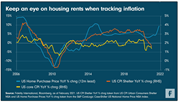
19 Feb 2021
Grafiek Fidelity: Huurprijzen richtinggevend voor inflatie
Fidelity International verwacht voor het komende jaar stijgende huur- en huizenprijzen in de VS, zo schrijft ze bij haar grafiek van de week.
Na de financiële crisis bereikte de kerninflatie (CPI) in 2010 zijn laagste punt onder invloed van de lage huurprijzen. Dit keer gaat het anders, want hoewel de huurindicatoren zwak zijn, zorgen ze voor een opwaartse druk op de inflatiecijfers. De huren stegen in januari met 1,6 procent ten opzichte van een jaar eerder, terwijl de Amerikaanse CPI en de core CPI beide met 1,4 procent stegen.
De grafiek laat zien dat de huizenprijzen sterk zijn gestegen, terwijl ook de huurprijzen – zij het wat bescheidener – omhoog zijn gegaan. Dit is van belang voor de inflatie, aangezien de CPI wordt berekend op basis van de huurprijzen en niet op basis van de huizenprijzen.
Andere tekenen wijzen ook op hogere huren in 2021. In de steden die het zwaarst zijn getroffen door corona, trekt de huurvraag aan. Bovendien daalde de voorraad verhuurbare woningen voor het eerst sinds maart, omdat de stijgende huizenprijzen verhuurders doet besluiten hun woning te verkopen in plaats van te verhuren. Na verloop van tijd zou deze daling van het aantal huurwoningen ten opzichte van het aantal te koop staande woningen ertoe moeten leiden dat het verschil tussen de huur- en de koopprijzen kleiner wordt.
Hieronder vindt u het volledige bericht:
Chart Room: Keep an eye on housing rents when tracking inflation
Some key considerations make us more constructive on US rents for the year ahead, particularly soaring home purchase prices.
The current environment offers one of the best chances in a long time for the US to generate inflation, driven by the fiscal and monetary response to the pandemic, the reversal of globalisation and moves towards improving social safety nets and redistributing money to lower earners. The key caveat had been that rents (the largest part of the US inflation basket) would be very weak for 2021, but the outlook appears more positive.
Core CPI troughed in 2010 following the global financial crisis, driven by weakness in rents. This time, although rent indicators are weak relative to recent history, rents are still a positive upward contributor to the overall index. Rents are up 1.6 per cent in January versus a year earlier while US CPI and core CPI were both up 1.4 per cent.
This week’s Chart Room shows house prices are soaring while rental prices (as represented by CPI Shelter) have increased at a slower pace. This has significance for inflation, given it is rents that are inputted into the CPI calculation, not home purchase prices.
Other signs also point to higher rents in 2021. We are starting to see rental demand rebound in the hardest hit cities. In New York during last November, there were more new leases signed than in any other November over the past decade, with Manhattan seeing a 30 per cent rise in leases compared to the same period in 2019. This comes after rental demand rebounded some months ago, except in the worst-affected cities.
In addition, inventory of rentable housing fell for the first time since March, perhaps because soaring house prices are causing landlords to consider selling rather than letting their property. Over time, this decrease in the supply of rental properties relative to the number of homes for sale should cause the divergence in rental and sale price trends to narrow.
Notes to editors
Voor meer informatie:
Lieke Liefkes, Stampa
fidelity@stampacommunications.com
+31 (0)20 404 2630
This material is provided to you in your capacity as media agency/journalist. The material serves exclusively as background information. Rewriting of content is under your responsibility unless otherwise agreed.


